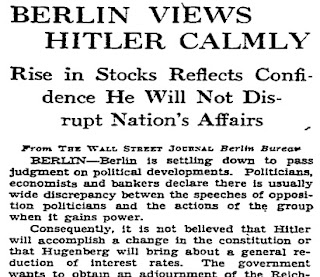At Last: How to Invest During the Collapse of Civilization
Finally, a journalist has had the courage to pen an article
on this vitally important topic: What is the correct investment strategy during
a period of something that closely resembles fascism?
For too long, writers have focused on the fears of the potential
victims of a Trump presidency and, even if he loses the election, the groups of
people who might be targeted by the increasingly muscular populist right wing
in the U.S.
Reporters covering Brexit have too often relaxed into the
comfortable role of merely documenting the rise in racist and xenophobic hate
crime since the referendum.
But now at last, courtesy of the Wall Street Journal,
we have a fearless article that tackles the elephant in the room: How should
investors respond to the rise on both sides of the Atlantic of something which
appears to have a lot in common with fascism?
In ‘The
Trump Trade: A Bet on the End of Reagan’s Market Legacy’, James Mackintosh
doesn’t actually use the f-word, preferring such formulations as “the populist
backlash against global elites”, but the message nevertheless is clear: This trend
will be around for a while, and “investors should prepare.”
“Betting on the rise of populism is at least as tough” as
betting on Reaganomics was in the 1980s, the hack sagely notes, “even for
investors who are proved right”.
The article refers back mainly to the 1970s and ‘80s for
comparison purposes, rather than the decade that the current one most resembles,
the 1930s, which I thought was a missed opportunity.
I began to wonder if anyone had been brave enough during the
rise of actual, historic Fascism in Europe to provide the investors of the day
with some much needed advice. Perhaps even an article with a title along the
lines of: ‘The Hitler Trade: A Bet on the End of the Fragile Democracy of Weimar
Germany’.
As it happens, the U.S. media’s coverage of the rise of Adolf Hitler is the subject of a 2009 student research paper by a fellow named David
Rabie. The paper is available
online and makes interesting reading.
On 24 January, 1933, the New York Times began
reporting on the plight of a Jewish professor in Germany called Ernst Cohn, who
had been the subject of violent protests by Nazi students.
“The following day the paper had a follow-up article on
Cohn, stating that he had resumed teaching despite the fact that Nazi students
used tear gas and firecrackers in protest,” writes Rabie.
“The article does not criticize all the protests and
violence, and only has one sentence saying that Cohn was being singled out for his
Jewish faith. Towards the end of the article, however, the paper does mention
that academic freedom was being threatened. The Wall Street Journal did
not choose to report on the Cohn incident, but rather on the fate of Americans
who held German bonds.”



Comments
Post a Comment